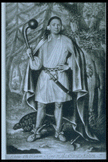Important note: The images below are some
of the images presented in class. Students are also directed to visit
the web sites listed on the online syllabus for additional artistic representations
of the encounter between native people and Europeans and Euro-Americans.
Image 1: "Columbus Landing at the West Indies," 1492 -- woodcut
This image allegedly depicts the landing of Christopher Columbus in the New World, 1492. There are several things to note about this representation of the encounter. First, the gentleman at the bottom left of the image sitting on the throne is meant to be King Ferdinand of Spain, adorned with a crown featuring the cross, a Christian symbol. The King looks as if he is giving his blessings to Columbus and his men, while also directing them to a suitable disembarkation point. Did the artist mean to convey a notion of the King's omnipotence? Second, two of the three ships pictured are empty. What might this be significant? Third, examine the perspective and scale of the figures in this work. Why are the natives physically so huge, in comparison with the explorers and even their ships? Why is the King even larger than the natives?
This image is the first alleged representation of native peoples on the North American continent. In what kinds of activities are these native people engaged here? The text that accompanied this image purported some rather fantastical attributes to indigenous Americans: "They are handsome, well-shaped in body, naked..[they] possess nothing individually," including their wives, which "the men take those who please them, be they mothers, sisters, or friends...they make no distinction. They also fight with each other, they eat each other, even those who are slain, and hang the flesh of them in the smoke. They become 150 years of age, and have no government." How does this image and the description of lifeways reinforce Europeans' assumptions of superiority? What elements of these alleged lifeways constitute the antithesis of "civilization" in the eyes of early 16th century Europeans?
Note how the artist, John
White, and the engraver, Theodor de Bry, positioned the "nobility" of the
Algonquian tribe, above the many hunters on the plain below. Also
note the classical-style poses of these nobles, who wrote one authority,
struck poses much as had Roman senators in classical paintings. White's
images routinely depicted the great wealth of animal life in the New World,
and he was fascinated with the ways that Indians took advantage of these
resources. White traveled to the eastern coast of North America twice
during the 1580s. These images first appeared in Richard Hakylut's
1590 publication, A briefe and true report of the new found land of
Virginia. For more images from this text, visit the site Exploring
the Carolinas (Memory): American Treasures of the Library of Congress
.
Note the pose of this subject, how closely it resembles the ancient Pan. See also the abundant wildlife (waterfowl, deer) and many hunting parties, both on land and in canoes on the river. The caption for this image read in the original, "They [Indians] are very familiar with devils, of whom they inquire what their enemies do." The juxtaposition of classical figures with natural abundance suggests an "earthly paradise," inhabited by gods, warriors, magicians and others -- an often typical view held by early Europeans about native peoples.
 This
and the next image depict various stages of acculturation of Euro-American
material goods and clothing by Indian people. Note the subject's
facial tatoos and deerskin mocassins, but also see that he wears a classical-style
tunic and a long flowing cape, and he also carries a European sword.
Some of these European items were given to Etow Oh Koam when he visited
Europe in the early 1700s.
This
and the next image depict various stages of acculturation of Euro-American
material goods and clothing by Indian people. Note the subject's
facial tatoos and deerskin mocassins, but also see that he wears a classical-style
tunic and a long flowing cape, and he also carries a European sword.
Some of these European items were given to Etow Oh Koam when he visited
Europe in the early 1700s.
Note the traditional Cherokee tribal attire and attributes -- facial and neck tatoos, hairstyle (especially the scalp lock) -- as well as the Anglo-American attire: sleeved shirt and the necklace with crosses and the coat of royal arms of King George III. Also note how Outacite appears at peace, posing solemly for the artist. In this representation of a respectable leader, the artist conveys little concern about hostility from natives people. An interesting study of other images of native peoples of the Southeast can be found at this site: Indians in the Trustees of Georgia Painting .
Image 7: "Indian Attack on Fort McKenzie," 1833 -- Karl Bodmer
Traveling with his son, Prince Maximillian of Wied, Karl Bodmer completed some of the earliest known paintings and sketches of tribal people on the northern great plains. Compare this image with those above. In what ways are Indians depicted differently? How are Euro-Americans responding to Indian actions? What emotions might such a sketch have aroused among Europeans and Americans at the time?
For other resources on Bodmer
and his art, visit the following sites of interest:
Museum
of Nebraska Art